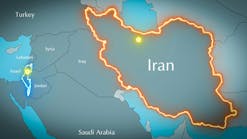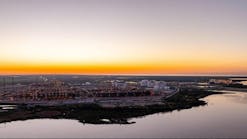- Conoco's Gulf of Mexico Deepwater Exploration Program [113834 bytes]
- Conoco/Reading & Bates Ultradeepwater Drilling Capability [104573 bytes]
Included in the program are their joint venture plans to build a pioneering, $200 million, ultradeepwater dynamically positioned drillship to carry out the program. The drillship will be designed to drill and produce in waters as deep as 10,000 ft.
The 50-50 JV, Deepwater Drilling LLC, let contract to Samsung Heavy Industries Co. Ltd., Seoul, to build the drillship, and Conoco hired the JV drillship for the exploration program.
Reading & Bates will operate the drillship, to be classed DP-3 under classification rules of the American Bureau of Shipping. Under DP-3 classification, the rig will be designed with power and operating triple-redundancies under the most stringent operating and safety rules of the classification society, Conoco said.
Conoco estimates that more than 10 billion bbl of oil equivalent reserves remain to be tapped from the ultradeepwater Gulf of Mexico.
Conoco's strategy
Deepwater drilling in the Gulf of Mexico is part of Conoco's long-term strategy "to re-position our U.S. upstream portfolio for growth," said Archie W. Dunham, Conoco president and chief executive officer.
Dunham said, "We've been working on a deepwater strategy for about 4 years, and we've identified around the world deepwater opportunities in basins that we prioritized in some areas of great interest; and when these became available, we went after them. And we were successful in getting particular blocks that we wanted in the Gulf of Mexico, as well as other regions of the world. The job now is to get them developed...We've come up with what we think is a really innovative way to efficiently develop the reserves, and we're excited about the challenge."
Paul B. Loyd Jr., chairman, president, and chief executive officer of Reading & Bates, said the JV agreement "marks the way of the future for oil companies and contractors to work together to execute their long-term strategies and achieve a very good financial return while doing so."
Loyd said, "We believe this partnership is unique in several ways. But primarily, we believe this is the first partnership between a contractor and an operator that is specifically designed to provide a broad range of hardware and support personnel that will provide significant advantages to Conoco in its effort to achieve its strategic objectives."
What's planned
The drillship will evaluate 60 federal blocks in the Gulf of Mexico in 2,000-9,000 ft of water in which Conoco is an interest owner. Most of the blocks are in water depths greater than 5,000 ft.
Conoco acquired 33 blocks in Central Gulf of Mexico Sale 157 in April, and the remaining 27 in Western Gulf of Mexico Sale 161 in September. But Conoco has additional deepwater acreage acquired in previous sales that also could be explored.
Identified blocks from sales occurring in the last 12 months are in the Garden Banks, Mississippi Canyon, Green Canyon, Keathley Canyon, Walker Ridge, Alaminos Canyon, and Atwater Valley areas.
Dunham said, "We expect to drill 3-4 exploratory wells each year beginning in 1998, when the drillship is completed."
No locations have been selected yet.
The JV plans to use the ship exclusively in the Gulf of Mexico, but has the flexibility to move it to other areas of the world as needed, based on the vessel's world-class design.
New generation tool
"In our view," said Reading & Bates' Loyd, "the industry is going to need many more vessels like this."
The vessel has the operational flexibility to carry out extended well testing and includes onboard storage and off- loading capacity and a provision for simultaneous testing and drilling with Reading & Bates' proprietary process. It also can be converted to a floating production, storage, and offloading vessel (FPSO).
The vessel will be named by Conoco Gulf Coast employees. Construction will commence in June 1997, and delivery is set for September 1998.
The double-hull vessel is being designed for continuous operation in a 10-year storm condition, capable of withstanding 60-knot winds and waves exceeding 18 ft, and the vessel's maneuvering system will enable it to optimize its heading and continue to operate even in storm conditions.
Samsung Pres. H.K. Lee said the vessel's design and safety systems "will provide the operator with better safety and efficiency without any interruption to drilling operations."
The vessel will be equipped with six thrusters for stationkeeping. Each will have 4,000 kw of power. The azimuthing thrusters will produce 32,000 hp and have variable-speed alternating current with fixed-pitch propellers to gain operating reliability and increase fuel efficiency.
It will have three redundant engine rooms, and Conoco said the vessel's uniqueness comes from its power distribution system. The ship will be able to operate at full capacity and maintain station even if one engine room is lost to fire, flood, or explosion. It can operate on five thrusters, if need be, in storm conditions.
Conoco said, "To date, no other drillship has been designed for an operating conditions this extreme to provide for such stringent layers of safety systems, redundancy, and reliability."
Vessel specifics
The 103,000-dwt vessel will be rated to drill 25,000-ft wells. It will have a 7,500 ft equipped water-depth rating initially but can be readily modified for 10,000 ft of water.
It will have a transit speed of 12 knots and accommodations for 130 personnel.
The vessel will be equipped with 6 low-emission diesel and/or heavy fuel oil engine generating sets with 47,000 total hp located in the three engine rooms to provide electric power for the drillship.
The vessel will be designed for zero discharge.
It will be 721 ft long, 140 ft wide, and 66 ft deep. Draft will total 42 ft-59 ft with thrusters in operation.
It will have 100,000 bbl of crude storage and be certificated for floating storage and offloading. It will be convertible to FPSO use, with 400,000 bbl storage.
Variable deck load will total 20,000 tons.
The helideck will accommodate a Sikorsky S61N helicopter.
Capabilities, systems
Materials for two typical deep complete wells can be loaded on board, eliminating the need for resupply during the course of drilling.
Other storage includes capacity for: 30,000 cu ft bulk, 10,000 sacks, 6,000 bbl drilling mud, 18,000 bbl drill water, 6,000 bbl brine, 3,000 bbl base oil, 7,500 bbl potable water, and 28,000 bbl heavy fuel oil and/or diesel.
Drilling and subsea equipment will include a 3,000-hp drawworks and a 2 million-lb, 48-ft by 40-ft derrick with a 1.5 million-lb hookload capacity. It will have a minimum capacity of 35,000 ft of 65/8-in. pipe and a stand capacity of 93 ft with simultaneous pipe and bottomhole assembly handling.
It will be equipped with a 1 million-lb crown-mounted active compensator and a 750-ton top-drive unit. Rotary will be a 400-hp, 60-in. hydraulic unit.
The vessel's mud system will consist of four 2,200-hp, 7,500-psi mud pumps.
It will accommodate 65/8-in. and 5-in. drillpipe for 25,000-ft drilling, and capacity for solids control totals 2,000 gal/min.
It will have an 183/4-in., 15,000-psi subsea blowout preventer with multiplex and electrohydraulic controls and a 21-in. riser equipped with 3-in. inner diameter 15,000-psi choke/kill lines plus a 4-in., 5,000-psi boost.
It will have six 160-kip dual riser tensioners and provision for two more.
Other systems and/or capabilities include: an anti-recoil, riser hangoff system; subsea tree handling; automated rig-floor functions; and drilling tubular riser and casing handling.
Cranes will include an 85-ton unit and three 60-ton pedestal units.
Copyright 1996 Oil & Gas Journal. All Rights Reserved.

